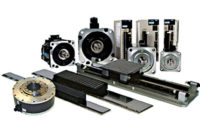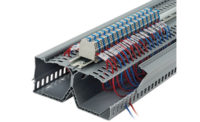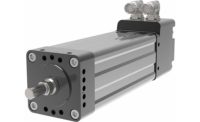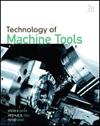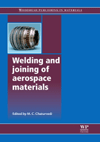Testra Corp. has introduced a new technology that virtually eliminates the noise and vibration associated with microstepping step motors.
Step motors are used in a variety of products, ranging from printers and disk drives to aircraft controls and CNC machine tools. One major reason for the growing popularity of steppers is the advent of microstepping drives, which have improved the motors’ smoothness and accuracy.
Yet, for many applications, microstepping technology still has some conspicuous drawbacks. Because of how they are driven, step motors are subject to vibration, noise and harmonic resonance issues. Even today’s microstepping motors can break tooling, such as router bits, when operating at higher speeds, and they often have chatter problems that create flaws when cutting arcs or circular shapes.
Now, Testra Corp. has introduced a new technology, “SoftStep” microstepping, that virtually eliminates such noise and vibration. “Through the SoftStep advancement to microstepping, a step motor drive is approaching the level of smooth performance of continuous rotation motors while still being a lower price option for machine builders,” says Thomas Hart, president of Testra.
Hart explains that SoftStep converts driver data into ultrafine microstepping (256 microsteps per motor step), ramping speeds up and down between steps to create smooth motion without clicking, buzzing or whining-even at high speeds.
Available in standard or custom versions, SoftStep treats input steps as small vector moves and smoothly chains them together, delivering smooth microstepping regardless of step size.
“The stepper motors were so quiet that I thought the machine wasn’t running,” says Matthew Dunne, president of Align-Rite Tool Co., which makes CNC routers and mills. “One of the reasons we’ve switched to Testra’s SoftStep drive systems is that you get really accurate, very quiet drives compared to other ones. It also allows you to cut faster, because the drives virtually eliminate vibration, so you get much smoother movement on your X, Y and Z axes.”
Thanks to SoftStep drives, Align-Rite’s wood routers can cut faster with smaller bits and do so with greater accuracy. And, because there’s less vibration, there is much less risk of breaking bits.
“For applications such as…Corian inlays, you must have a very smooth stepper system, so that you don’t have any chipping from vibration,” says Dunne.
CAMaster CNC, a manufacturer of CNC routers, lasers, and plasma cutters, uses Testra SoftStep drives on its three-axis Stinger CNC router for hobby and light industrial use.
“We wanted the Stinger models to offer the same accuracy, quietness and smoothness built into our larger routers, but with a stepper motor,” explains Joey Jarrard, CAMaster co-owner. “But most steppers produce the ‘growl’ noise that does not sound professional. So, after trying a few other driver packages, we chose a SoftStep plug-and-play drive system that was very quiet, smooth and accurate, almost like a more expensive servo system.”
CAMaster uses a four-axis SoftStep system, complete with power, drivers, connectors and PC cables. The fourth axis of control is like a bonus feature for his customers, says Jarrard.
“The Stinger is a three-axis machine, but we can upgrade to include a lathe on our machine. Since the SoftStep drive system comes with four [axes], we already have an extra drive available. So, the customer can install their fourth-axis machine without doing any additional wiring. Also, if a customer is not using the fourth axis, if one of the three drives goes out in the future, they have an extra drive available to get them back up and running in a matter of about one minute,” he says.
Stinger customers range from serious hobbyists to manufacturers of guitar bodies and stadium speakers. Jarrard says the lack of vibration from his routers’ stepper motors allows these high-quality products to be produced without having to smooth out nicks and other “chatter spots.”
“Even if you’re dealing with a couple of thousandths of an inch, [you can make] one cut and you’re done,” he says.
Jarrard adds that his SoftStep-controlled stepper motors are also cool to the touch. “Testra has got it figured out to where the drive is still holding when it’s not moving, but it’s not cranking out the maximum amperage that will make the motor hot,” he says. “That makes it safer for the customer because they’re not going to get burned as they might by a motor that is 130 or 140 degrees. Running cool also affects the longevity of the motor. I have seen motors with other drives burn out in a year or so because the heat causes the motor’s copper windings to melt together. So, with the motor running cool, it could last easily twice as long.”
For more information, call Testra at 480-966-8428 or visitwww.testra.com.
Motion Control: New, Quieter Stepper Drives Boost Performance
Looking for a reprint of this article?
From high-res PDFs to custom plaques, order your copy today!



